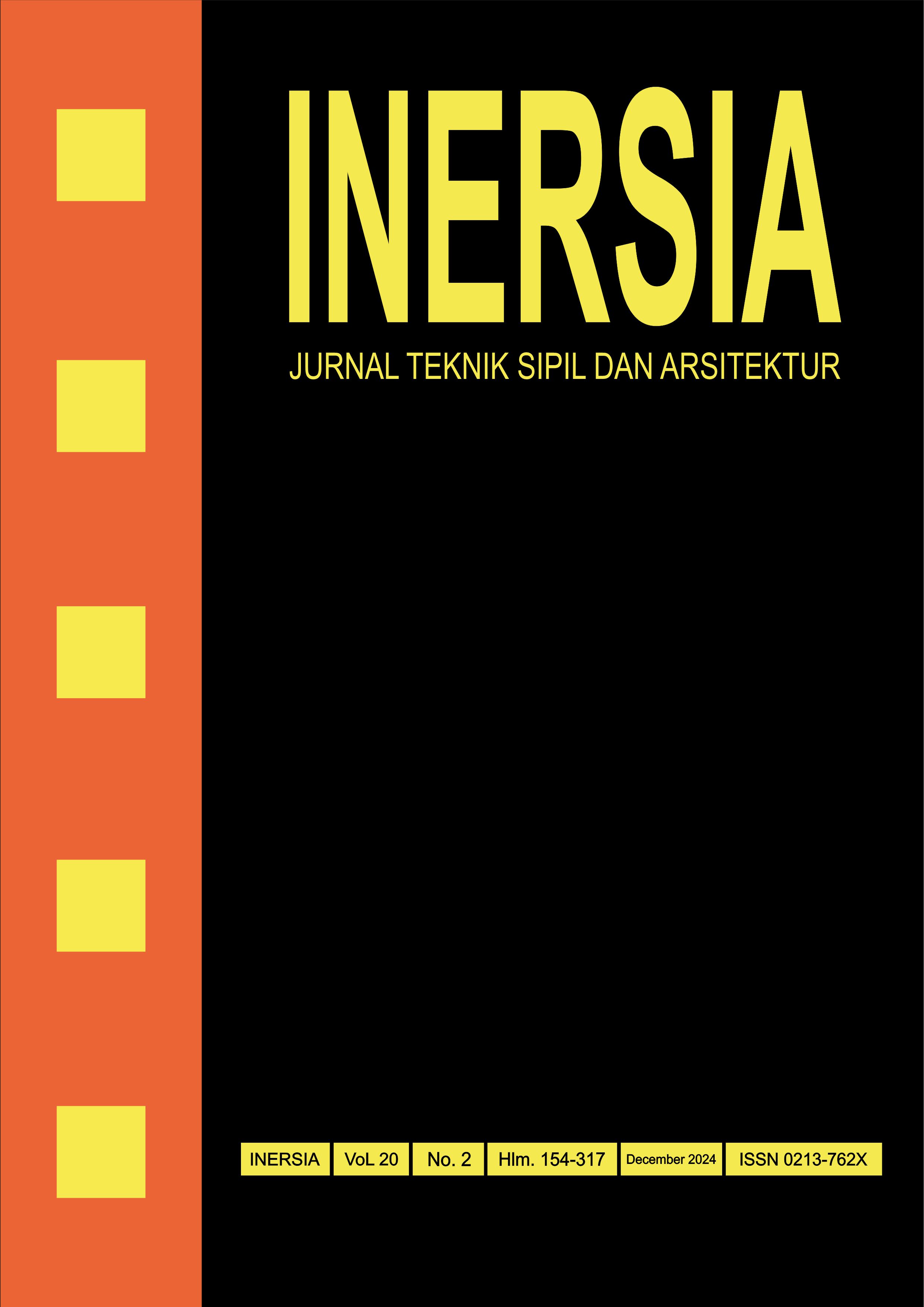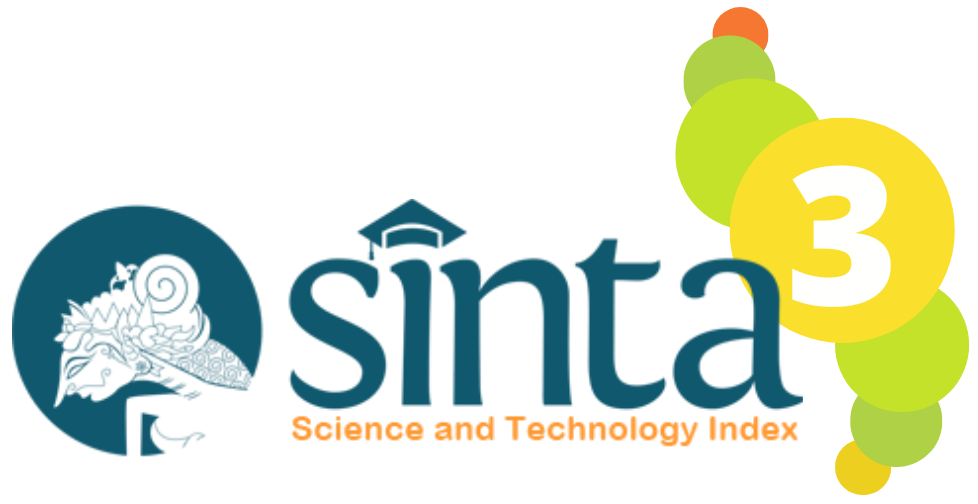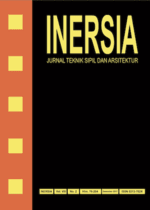Mix Design of Ambient Cured Geopolymer Concrete with Fly Ash, GGBFS, and Borax
DOI:
https://doi.org/10.21831/inersia.v20i2.74464Keywords:
Geopolymer, Fly ash, GGBFS, Borax additive, Ambient curedAbstract
Geopolymer cement, using fly ash (FA), presents a viable alternative to Portland cement. However, FA-based geopolymers often lack reactivity and strength, necessitating combination with calcium-rich materials like ground granulated blast furnace slag (GGBFS). However, GGBFS could accelerate setting and decrease workability, requiring a retarder. Borax is recognized for its retarding properties in FA-based geopolymers, but its impact in FA-GGBFS systems remains understudied. This study evaluated the influence of varying proportions of FA and GGBFS with the addition of borax, on the setting time, workability, and mechanical strength of the geopolymer paste, mortar, and concrete under ambient curing conditions. Setting time test was conducted for the geopolymer paste, flow table test for workability assessment of mortar, and compressive strength testing at 1, 7, and 28 days for the mechanical strength of paste and concrete. Various FA:GGBFS ratios (100:0, 70:30, 50:50, and 0:100) were examined. Alkali activator consists of NaOH and Na2SO3 with Na2SO3/NaOH ratio (R) of 1.5 and alkali to precursors ratio (A) of 0.45 was used. Borax was added at a constant 3% by weight of the precursors. Both the volume ratios of paste to fine aggregate voids (Rm) and mortar to coarse aggregate voids (Rb) were set to 1.5. Borax increased initial setting time by 7-33 minutes for FA-GGBFS geopolymer. GGBFS replacement decreased the workability of mortar, with flow index ranging from 83-158%. Increasing GGBFS content significantly improved compressive strength in both paste and concrete samples. Notably, 100% GGBFS replacement yielded the highest concrete strength at 74.86 MPa after 28 days. However, the optimal balance of properties was achieved with a 50% GGBFS replacement, resulting in satisfactory strengths of 100.29 MPa for paste and 69.08 MPa for concrete, along with a 40-minute initial setting time and a flow index of 138%. These findings surpass prior studies on similar geopolymers.
References
R. M. Andrew, "Global CO2 emissions from cement production," Earth Syst Sci Data, vol. 10, no. 1, pp. 195–217, Jan. 2018, doi: 10.5194/essd-10-195-2018.
F. Pacheco-Torgal, "Introduction to the environmental impact of construction and building materials," in Eco-efficient Construction and Building Materials, Elsevier, 2014, pp. 1–10. doi: 10.1533/9780857097729.1.
Md. F. S. Zawad, Md. A. Rahman, and S. N. Priyom, "Bio-Engineered Concrete: A Critical Review on The Next Generation of Durable Concrete," Journal of the Civil Engineering Forum, vol. 7, no. 3, p. 335, Aug. 2021, doi: 10.22146/jcef.65317.
K. C. Gomes, M. Carvalho, D. de P. Diniz, R. de C. C. Abrantes, M. A. Branco, and P. R. O. de Carvalho Junior, "Carbon emissions associated with two types of foundations: CP-II Portland cement-based composite vs. geopolymer concrete," Matéria (Rio de Janeiro), vol. 24, no. 4, 2019, doi: 10.1590/s1517-707620190004.0850.
A. N. Beskopylny et al., "Developing Environmentally Sustainable and Cost-Effective Geopolymer Concrete with Improved Characteristics," Sustainability, vol. 13, no. 24, p. 13607, Dec. 2021, doi: 10.3390/su132413607.
B. C. McLellan, R. P. Williams, J. Lay, A. van Riessen, and G. D. Corder, "Costs and carbon emissions for geopolymer pastes in comparison to ordinary portland cement," J Clean Prod, vol. 19, no. 9–10, pp. 1080–1090, Jun. 2011, doi: 10.1016/j.jclepro.2011.02.010.
T. BÅ‚aszczyÅ„ski and M. Król, "Usage of Green Concrete Technology in Civil Engineering," Procedia Eng, vol. 122, pp. 296–301, 2015, doi: 10.1016/j.proeng.2015.10.039.
K. K. D. Sungkono, I. Satyarno, H. Priyosulistyo, and I. Perdana, "Corrosion Resistance of High Calcium Fly Ash Based Reinforced Geopolymer Concrete in Marine Environment," Civil Engineering and Architecture, vol. 11, no. 5A, pp. 3175–3189, Sep. 2023, doi: 10.13189/cea.2023.110827.
I. Garcia Lodeiro, N. Cristelo, A. Palomo, and A. Fernández-Jiménez, "Use of industrial by-products as alkaline cement activators," Constr Build Mater, vol. 253, p. 119000, Aug. 2020, doi: 10.1016/j.conbuildmat.2020.119000.
M. Olivia, L. M. Tambunan, and E. Saputra, "Properties of Palm Oil Fuel Ash (POFA) Geopolymer Mortar Cured at Ambient Temperature," MATEC Web of Conferences, vol. 97, p. 01006, Feb. 2017, doi: 10.1051/matecconf/20179701006.
L. S. Wong, "Durability Performance of Geopolymer Concrete: A Review," Polymers (Basel), vol. 14, no. 5, p. 868, Feb. 2022, doi: 10.3390/polym14050868.
S. Parathi, P. Nagarajan, and S. A. Pallikkara, "Ecofriendly geopolymer concrete: a comprehensive review," Clean Technol Environ Policy, vol. 23, no. 6, pp. 1701–1713, Aug. 2021, doi: 10.1007/s10098-021-02085-0.
N. A. K. Reddy and K. Ramujee, "Comparative study on mechanical properties of fly ash-GGBFS based geopolymer concrete and OPC concrete using nano-alumina," Mater Today Proc, vol. 60, pp. 399–404, Jan. 2022, doi: 10.1016/j.matpr.2022.01.260.
S. S. S and R. Kolli, "Experimental investigation on mechanical properties of fly ash-GGBFS based GO-geopolymer concrete using mineral sand (Quartz-Feldspar) as fine aggregate," Mater Today Proc, vol. 60, pp. 40–45, Jan. 2022, doi: 10.1016/j.matpr.2021.11.325.
S. Y. Oderji, B. Chen, M. R. Ahmad, and S. F. A. Shah, "Fresh and hardened properties of one-part fly ash-based geopolymer binders cured at room temperature: Effect of slag and alkali activators," J Clean Prod, vol. 225, pp. 1–10, Jul. 2019, doi: 10.1016/j.jclepro.2019.03.290.
P. Nath and P. K. Sarker, "Effect of GGBFS on setting, workability and early strength properties of fly ash geopolymer concrete cured in ambient condition," Constr Build Mater, vol. 66, pp. 163–171, Sep. 2014, doi: 10.1016/j.conbuildmat.2014.05.080.
S. Nagajothi and S. Elavenil, "Effect of GGBS Addition on Reactivity and Microstructure Properties of Ambient Cured Fly Ash Based Geopolymer Concrete," Silicon, vol. 13, pp. 507–516, 2021, doi: 10.1007/s12633-020-00470-w/Published.
S. Sasui, G. Kim, J. Nam, T. Koyama, and S. Chansomsak, "Strength and Microstructure of Class-C Fly Ash and GGBS Blend Geopolymer Activated in NaOH & NaOH + Na2SiO3," Materials, vol. 13, no. 1, p. 59, Dec. 2019, doi: 10.3390/ma13010059.
X. Chen and P. Mondal, "Sucrose retards the reaction of non"calcium geopolymers: An implication for developing kinetics"controlling admixtures," Journal of the American Ceramic Society, vol. 104, no. 6, pp. 2894–2907, Jun. 2021, doi: 10.1111/jace.17706.
B. Nematollahi and J. Sanjayan, "Effect of different superplasticizers and activator combinations on workability and strength of fly ash based geopolymer," Mater Des, vol. 57, pp. 667–672, May 2014, doi: 10.1016/j.matdes.2014.01.064.
A. Antoni, A. A. T. Purwantoro, W. S. P. D. Suyanto, and D. Hardjito, "Fresh and Hardened Properties of High Calcium Fly Ash-Based Geopolymer Matrix with High Dosage of Borax," Iranian Journal of Science and Technology - Transactions of Civil Engineering, vol. 44, pp. 535–543, Oct. 2020, doi: 10.1007/s40996-019-00330-7.
R. Cornelis, H. Priyosulistyo, and I. Satyarno, "Workability and Strength Properties of Class C Fly Ash-Based Geopolymer Mortar," in Sustainable Civil Engineering Structures and Construction Materials, 2018. doi: 10.1051/matecconf/20192.
M. Putri, I. Satyarno, and D. Sulistyo, "Pengaruh Penambahan Borax terhadap Setting Time Pasta Geopolymer Berbahan Dasar Fly Ash dan Ground Granulated Blast Furnace Slag," in Simposium Nasional Teknologi Infrastruktur, Yogyakarta, 2024.
H. Ma et al., "Preparation and Reaction Mechanism Characterization of Alkali-activated Coal Gangue–Slag Materials," Materials, vol. 12, no. 14, p. 2250, Jul. 2019, doi: 10.3390/ma12142250.
R. M. Waqas, F. Butt, X. Zhu, T. Jiang, and R. F. Tufail, "A Comprehensive Study on the Factors Affecting the Workability and Mechanical Properties of Ambient Cured Fly Ash and Slag Based Geopolymer Concrete," Applied Sciences, vol. 11, no. 18, p. 8722, Sep. 2021, doi: 10.3390/app11188722.
T. W. Cheng and J. P. Chiu, "Fire-resistant geopolymer produced by granulated blast furnace slag," Miner Eng, vol. 16, no. 3, pp. 205–210, Mar. 2003, doi: 10.1016/S0892-6875(03)00008-6.
P. Pavithra, M. Srinivasula Reddy, P. Dinakar, B. Hanumantha Rao, B. K. Satpathy, and A. N. Mohanty, "Effect of the Na 2 SiO 3 /NaOH Ratio and NaOH Molarity on the Synthesis of Fly Ash-Based Geopolymer Mortar," in Geo-Chicago 2016, Reston, VA: American Society of Civil Engineers, Aug. 2016, pp. 336–344. doi: 10.1061/9780784480151.034.
I. Satyarno, A. P. Solehudin, C. Meyarto, D. Hadiyatmoko, P. Muhammad, and R. Afnan, "Practical Method for Mix Design of Cement-based Grout," Procedia Eng, vol. 95, pp. 356–365, Jan. 2014, doi: 10.1016/J.PROENG.2014.12.194.
H. Liu, J. G. Sanjayan, and Y. Bu, "The application of sodium hydroxide and anhydrous borax as composite activator of class F fly ash for extending setting time," Fuel, vol. 206, pp. 534–540, Oct. 2017, doi: 10.1016/j.fuel.2017.06.049.
S. E. Thomas, A. Muhsin Lebba, S. Sreeja, and K. P. Ramaswamy, "Effect of borax in slag-fly ash-based alkali activated paste," IOP Conf Ser Earth Environ Sci, vol. 1237, no. 1, p. 012006, Sep. 2023, doi: 10.1088/1755-1315/1237/1/012006.
P. Li, D. Chen, Z. Jia, Y. Li, S. Li, and B. Yu, "Effects of Borax, Sucrose, and Citric Acid on the Setting Time and Mechanical Properties of Alkali-Activated Slag," Materials, vol. 16, no. 8, p. 3010, Apr. 2023, doi: 10.3390/ma16083010.
T. Pahlawan, J. Tarigan, J. J. Ekaputri, and A. Nasution, "Effect of Borax on Very High Calcium Geopolymer Concrete," Int J Adv Sci Eng Inf Technol, vol. 13, no. 4, pp. 1387–1392, Aug. 2023, doi: 10.18517/ijaseit.13.4.18291.
J. Yang and C. Qian, "Effect of borax on hydration and hardening properties of magnesium and pottassium phosphate cement pastes," Journal of Wuhan University of Technology-Mater. Sci. Ed., vol. 25, no. 4, pp. 613–618, Aug. 2010, doi: 10.1007/s11595-010-0055-6.
P. Nuaklong, K. Janprasit, and P. Jongvivatsakul, "Enhancement of strengths of high-calcium fly ash geopolymer containing borax with rice husk ash," Journal of Building Engineering, vol. 40, Aug. 2021, doi: 10.1016/j.jobe.2021.102762.
Y. Ling, K. Wang, W. Li, G. Shi, and P. Lu, "Effect of slag on the mechanical properties and bond strength of fly ash-based engineered geopolymer composites," Compos B Eng, vol. 164, pp. 747–757, May 2019, doi: 10.1016/j.compositesb.2019.01.092.
M. N. S. Hadi, N. A. Farhan, and M. N. Sheikh, "Design of geopolymer concrete with GGBFS at ambient curing condition using Taguchi method," Constr Build Mater, vol. 140, pp. 424–431, Jun. 2017, doi: 10.1016/j.conbuildmat.2017.02.131.
P. Chindaprasirt, P. De Silva, K. Sagoe-Crentsil, and S. Hanjitsuwan, "Effect of SiO2 and Al2O3 on the setting and hardening of high calcium fly ash-based geopolymer systems," J Mater Sci, vol. 47, no. 12, pp. 4876–4883, Jun. 2012, doi: 10.1007/s10853-012-6353-y.
Q. Zhong, X. Tian, G. Xie, X. Luo, and H. Peng, "Investigation of Setting Time and Microstructural and Mechanical Properties of MK/GGBFS-Blended Geopolymer Pastes," Materials, vol. 15, no. 23, p. 8431, Nov. 2022, doi: 10.3390/ma15238431.
B. Kanagaraj, A. N, U. J. Alengaram, S. Raj R, P. B, and K. Tattukolla, "Performance evaluation on engineering properties and sustainability analysis of high strength geopolymer concrete," Journal of Building Engineering, vol. 60, Nov. 2022, doi: 10.1016/j.jobe.2022.105147.
P. S. Deb, P. Nath, and P. K. Sarker, "Properties Of Fly Ash And Slag Blended Geopolymer Concrete Cured At Ambient Temperature," in Proceedings of the New Developments in Structural Engineering and Construction, Singapore: Research Publishing Services, 2013, pp. 571–576. doi: 10.3850/978-981-07-5354-2_M-55-433.
M. H. Al-Majidi, A. Lampropoulos, A. Cundy, and S. Meikle, "Development of geopolymer mortar under ambient temperature for in situ applications," Constr Build Mater, vol. 120, pp. 198–211, Sep. 2016, doi: 10.1016/j.conbuildmat.2016.05.085.
W. Teo, K. Shirai, J. H. Lim, L. B. Jack, and E. Nikbakht, "Experimental Investigation on Ambient-Cured One-Part Alkali-Activated Binders Using Combined High-Calcium Fly Ash (HCFA) and Ground Granulated Blast Furnace Slag (GGBS)," Materials, vol. 15, no. 4, Feb. 2022, doi: 10.3390/ma15041612.
Z. Zhang, J. L. Provis, A. Reid, and H. Wang, "Mechanical, thermal insulation, thermal resistance and acoustic absorption properties of geopolymer foam concrete," Cem Concr Compos, vol. 62, pp. 97–105, Sep. 2015, doi: 10.1016/j.cemconcomp.2015.03.013.
R. R. Bellum, "Influence of steel and PP fibers on mechanical and microstructural properties of fly ash-GGBFS based geopolymer composites," Ceram Int, vol. 48, no. 5, pp. 6808–6818, Mar. 2022, doi: 10.1016/j.ceramint.2021.11.232.
R. R. Bellum, K. Muniraj, and S. R. C. Madduru, "Characteristic Evaluation of Geopolymer Concrete for the Development of Road Network: Sustainable Infrastructure," Innovative Infrastructure Solutions, vol. 5, no. 3, p. 91, Dec. 2020, doi: 10.1007/s41062-020-00344-5.
R. R. Bellum, K. Muniraj, and S. R. C. Madduru, "Influence of slag on mechanical and durability properties of fly ash-based geopolymer concrete," Journal of the Korean Ceramic Society, vol. 57, no. 5, pp. 530–545, Sep. 2020, doi: 10.1007/s43207-020-00056-7.
A. Wardhono, D. W. Law, and A. Strano, "The Strength of Alkali-activated Slag/fly Ash Mortar Blends at Ambient Temperature," Procedia Eng, vol. 125, pp. 650–656, 2015, doi: 10.1016/j.proeng.2015.11.095.
B. Gopalakrishna and P. Dinakar, "Mix design development of fly ash-GGBS based recycled aggregate geopolymer concrete," Journal of Building Engineering, vol. 63, Jan. 2023, doi: 10.1016/j.jobe.2022.105551.
A. Brykov and M. Voronkov, "Dry Mix Slag"”High-Calcium Fly Ash Binder. Part One: Hydration and Mechanical Properties," Materials Sciences and Applications, vol. 14, no. 03, pp. 240–254, 2023, doi: 10.4236/msa.2023.143014.
Downloads
Published
How to Cite
Issue
Section
License
Authors who publish with INERSIA journal agree to the following terms:
- Authors retain copyright and grant the INERSIA journal right of first publication with the work simultaneously licensed under Creative Commons Attribution License (CC BY 4.0) that allows others to share the work with an acknowledgment of the work's authorship and initial publication in this journal.
- Authors can enter into separate, additional contractual arrangements for the non-exclusive distribution of the published version of the work (e.g., post it to an institutional repository or edit it in a book), with an acknowledgment of its initial publication in this journal.
- Authors are permitted and encouraged to post their work online (e.g., in institutional repositories or on their website) before and during the submission process, as it can lead to productive exchanges, as well as earlier and greater citation of published work.

INERSIA by https://journal.uny.ac.id/index.php/inersia was distributed under a Creative Commons Attribution 4.0 International License











